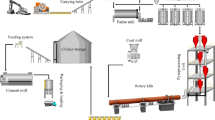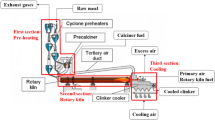Abstract
This paper presents an investigation of the effects of temperature gradient distribution by the aid of a secondary burner on exergetic and environmental functions of the cement production process. For this reason, the burning system of the cement production (kiln & preheater) process was simulated in four thermal areas. Three lines of cement production with 2,000, 2,300 and 2,600 ton/day were investigated. Fuel injection ratio into the secondary burner, from 10 to 40 percent was studied for each line. The obtained results show that, for cyclone preheaters, fuel injection into the secondary burner up to a proportion resulting in the minimum temperature required for alite formation (2,200 °C) in the kiln burning zone is suitable. For shaft preheaters, however, according to percent calcinations, there exists an optimum proportion for 15 to 20 percent injection fuel into secondary burner. Finally, it was shown that the secondary burner application can reduce the exergy losses about 25 percent, which leads to a reduction of the green house gases of about 35000 cubic meters per year for each ton per day of clinker production.
Similar content being viewed by others
References
Z. Rant, Forsch. Ing. Wes., 22, 36 (1956).
F. Bosnjakovic, Technical Thermodynamics, Holt, Rinehart & Winston, New York (1965).
J. Szargut, D.R. Morris and F. R. Steward, Exergy Analysis of Thermal, Chemical and Metallurgical Processes, Hemisphere Publishing Corporation, New York, London (1988).
T. J. Kotas, the Exergy Method of Thermal Plant Analysis. Krieger Publishing Company, Malabar, Florida (1995).
A. Bejan, Entropy Generation through Heat & Fluid Flow, Wiley, New York (1982).
A. Bejan, Advanced Engineering Thermodynamics, Wiley, New York (2006).
A. Bejan, G. Tsatsaronis and M. Moran, Thermal Design & Optimization, Wiley, New York (1996).
U. Kaantee, R. Zevenhoven, R. Backman and M. Hupa, Cement manufacturing using alternative fuels and the advantages of process modeling, Recovery, Recycling, Re-integration, Feb. 12–15, Geneva, Switzerland (2002).
W. T. Choate, Energy and Emission Reduction Opportunities for the Cement Industry, U.S. Department of Energy, Energy Efficiency and Renewable Energy (2003).
C. Koroneos, G. Roumbas and N. Moussiopoulos, Int. J. Exergy, 2(1), 55 (2005).
T. Kawaes, Cement Process and Energy Saving, the Energy Conservation Center, Japan (2006).
Z. Sogut and Z. Oktay, Int. J. Exergy, 5(5), 218 (2008).
F. Zeman and K. Lakcner, The Reduced Emission Oxygen Kiln, A White Paper Report for the Cement Sustainability Initiative of the World Business Council on Sustainable Development, Lenfest Center for Sustainable Energy Columbia University in New York Report No. 2008.01. (2008).
E. Worrell, C. Galitsky and L. Price, Energy efficiency improvement opportunities for the cement industry, Environmental Energy Technologies Division Lawrence Berkeley National Laboratory (2008).
Z. Sogut, Z. Oktay and H. Karakoc, Appl. Therm. Eng., 30(8–9), 817 (2010).
Z. Sogut, Z. Oktay and A. Hepbasli, Int. J. Exergy (IJEX), 6, Issue 5 (2009).
S. S. Park and H.Y. Kang, Korean J. Chem. Eng., 23(3), 367 (2006).
Y.C. Ahn, J.M. Cho, G.T. Kim, S.R. Cha, J.K. Lee, Y.O. Park, S. D. Kim and S. H. Lee, Korean J. Chem. Eng., 21(1), 182 (2004).
E. P. Kurt, Cement Manufacturers’ Handbook, Chemical Publishing Co. Inc. New York (1979).
B. Kohlhaas and O. Labahn, Cement Engineers’ Handbook, 4th Ed. Int. Public Service (1982).
W. H. Duda, Cement Data Book (1), Bauverlag GmbH (1985).
A. A. Boateng, Rotary Kilns: Transport Phenomena and Transport Processes, Elsevier (2008).
P. A. Alsop, The Cement Plant Operation Hand Book, International Cement Review (2010).
S. A. Ashrafizadeh, Sanat Siman, 90, 8 (2007).
N. Sato, Chemical energy and exergy an introduction to chemical thermodynamics for engineering, Elsevier, First Ed., 112 (2004).
S.A. Ashrafizadeh, Designing of a clinker burning pilot plant, M.Sc. thesis, Adviser: Dr. A. Taeb, Cement Research Center, Chemical Eng. Group, Iran University of Science and Technology, Sep. (1997).
Author information
Authors and Affiliations
Corresponding author
Rights and permissions
About this article
Cite this article
Ashrafizadeh, S.A., Amidpour, M. & Allahverdi, A. Exergetic and environmental performance improvement in cement production process by driving force distribution. Korean J. Chem. Eng. 29, 606–613 (2012). https://doi.org/10.1007/s11814-011-0226-y
Received:
Accepted:
Published:
Issue Date:
DOI: https://doi.org/10.1007/s11814-011-0226-y




